Infection structure-specific expression of β-1,3-glucan synthase is essential for pathogenicity of Colletotrichum graminicola and evasion of β-glucan-triggered immunity in maize
- PMID: 23898035
- PMCID: PMC3723631
- DOI: 10.1105/tpc.112.103499
Infection structure-specific expression of β-1,3-glucan synthase is essential for pathogenicity of Colletotrichum graminicola and evasion of β-glucan-triggered immunity in maize
Abstract
β-1,3-Glucan and chitin are the most prominent polysaccharides of the fungal cell wall. Covalently linked, these polymers form a scaffold that determines the form and properties of vegetative and pathogenic hyphae. While the role of chitin in plant infection is well understood, the role of β-1,3-glucan is unknown. We functionally characterized the β-1,3-glucan synthase gene GLS1 of the maize (Zea mays) pathogen Colletotrichum graminicola, employing RNA interference (RNAi), GLS1 overexpression, live-cell imaging, and aniline blue fluorochrome staining. This hemibiotroph sequentially differentiates a melanized appressorium on the cuticle and biotrophic and necrotrophic hyphae in its host. Massive β-1,3-glucan contents were detected in cell walls of appressoria and necrotrophic hyphae. Unexpectedly, GLS1 expression and β-1,3-glucan contents were drastically reduced during biotrophic development. In appressoria of RNAi strains, downregulation of β-1,3-glucan synthesis increased cell wall elasticity, and the appressoria exploded. While the shape of biotrophic hyphae was unaffected in RNAi strains, necrotrophic hyphae showed severe distortions. Constitutive expression of GLS1 led to exposure of β-1,3-glucan on biotrophic hyphae, massive induction of broad-spectrum defense responses, and significantly reduced disease symptom severity. Thus, while β-1,3-glucan synthesis is required for cell wall rigidity in appressoria and fast-growing necrotrophic hyphae, its rigorous downregulation during biotrophic development represents a strategy for evading β-glucan-triggered immunity.
Figures
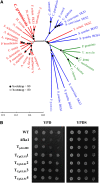
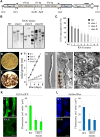
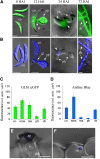
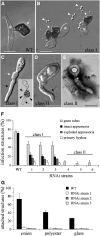
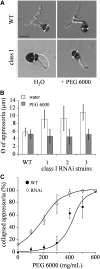
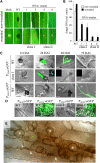
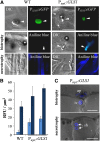

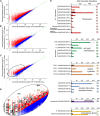

Similar articles
-
Attenuation of PAMP-triggered immunity in maize requires down-regulation of the key β-1,6-glucan synthesis genes KRE5 and KRE6 in biotrophic hyphae of Colletotrichum graminicola.Plant J. 2016 Aug;87(4):355-75. doi: 10.1111/tpj.13205. Epub 2016 Aug 18. Plant J. 2016. PMID: 27144995
-
Infection structure-specific reductive iron assimilation is required for cell wall integrity and full virulence of the maize pathogen Colletotrichum graminicola.Mol Plant Microbe Interact. 2013 Jun;26(6):695-708. doi: 10.1094/MPMI-01-13-0003-R. Mol Plant Microbe Interact. 2013. PMID: 23639025
-
The galactose metabolism genes UGE1 and UGM1 are novel virulence factors of the maize anthracnose fungus Colletotrichum graminicola.Mol Microbiol. 2024 May;121(5):912-926. doi: 10.1111/mmi.15242. Epub 2024 Feb 23. Mol Microbiol. 2024. PMID: 38400525
-
Plant infection and the establishment of fungal biotrophy.Trends Plant Sci. 2002 Aug;7(8):352-6. doi: 10.1016/s1360-1385(02)02297-5. Trends Plant Sci. 2002. PMID: 12167330 Review.
-
Colletotrichum: A model genus for studies on pathology and fungal-plant interactions.Fungal Genet Biol. 1999 Jul-Aug;27(2-3):186-98. doi: 10.1006/fgbi.1999.1143. Fungal Genet Biol. 1999. PMID: 10441444 Review.
Cited by
-
The fungal-specific β-glucan-binding lectin FGB1 alters cell-wall composition and suppresses glucan-triggered immunity in plants.Nat Commun. 2016 Oct 27;7:13188. doi: 10.1038/ncomms13188. Nat Commun. 2016. PMID: 27786272 Free PMC article.
-
Correspondence between symptom development of Colletotrichum graminicola and fungal biomass, quantified by a newly developed qPCR assay, depends on the maize variety.BMC Microbiol. 2016 May 23;16:94. doi: 10.1186/s12866-016-0709-4. BMC Microbiol. 2016. PMID: 27215339 Free PMC article.
-
Fungal Pathogenesis-Related Cell Wall Biogenesis, with Emphasis on the Maize Anthracnose Fungus Colletotrichum graminicola.Plants (Basel). 2022 Mar 23;11(7):849. doi: 10.3390/plants11070849. Plants (Basel). 2022. PMID: 35406829 Free PMC article. Review.
-
Genome-Wide Transcriptome Analysis Reveals the Comprehensive Response of Two Susceptible Poplar Sections to Marssonina brunnea Infection.Genes (Basel). 2018 Mar 12;9(3):154. doi: 10.3390/genes9030154. Genes (Basel). 2018. PMID: 29534547 Free PMC article.
-
Sandwich Enzyme-Linked Immunosorbent Assay for Quantification of Callose.Methods Protoc. 2022 Jun 26;5(4):54. doi: 10.3390/mps5040054. Methods Protoc. 2022. PMID: 35893580 Free PMC article.
References
-
- Afzal A.J., Wood A.J., Lightfoot D.A. (2008). Plant receptor-like serine threonine kinases: Roles in signaling and plant defense. Mol. Plant Microbe Interact. 21: 507–517 - PubMed
-
- Aimanianda V., Bayry J., Bozza S., Kniemeyer O., Perruccio K., Elluru S.R., Clavaud C., Paris S., Brakhage A.A., Kaveri S.V., Romani L., Latgé J.-P. (2009). Surface hydrophobin prevents immune recognition of airborne fungal spores. Nature 460: 1117–1121 - PubMed
-
- Almagro L., Gómez Ros L.V., Belchi-Navarro S., Bru R., Ros Barceló A., Pedreño M.A. (2009). Class III peroxidases in plant defence reactions. J. Exp. Bot. 60: 377–390 - PubMed
-
- Andrie R.M., Martinez J.P., Ciuffetti L.M. (2005). Development of ToxA and ToxB promoter-driven fluorescent protein expression vectors for use in filamentous ascomycetes. Mycologia 97: 1152–1161 - PubMed
-
- Barber M.S., Bertram R.E., Ride J.P. (1989). Chitin oligosaccharides elicit lignification in wounded wheat leaves. Physiol. Mol. Plant Pathol. 34: 3–12
Publication types
MeSH terms
Substances
Associated data
- Actions
LinkOut - more resources
Full Text Sources
Other Literature Sources
Molecular Biology Databases
Research Materials
Miscellaneous

